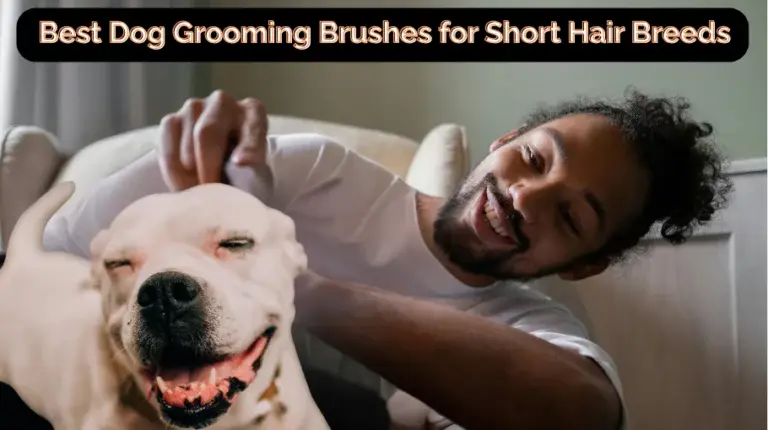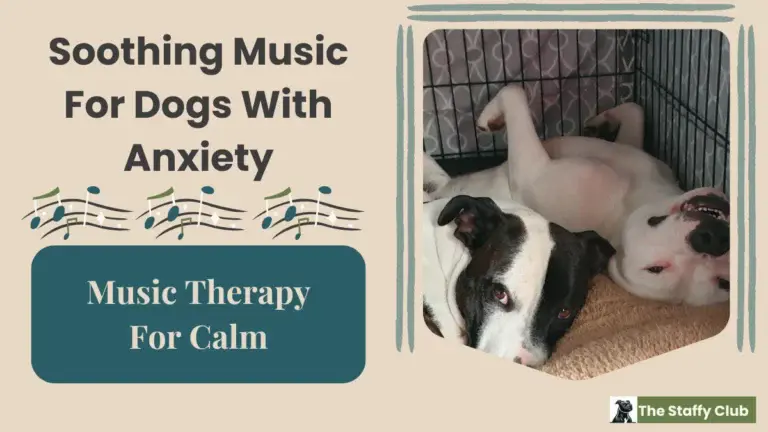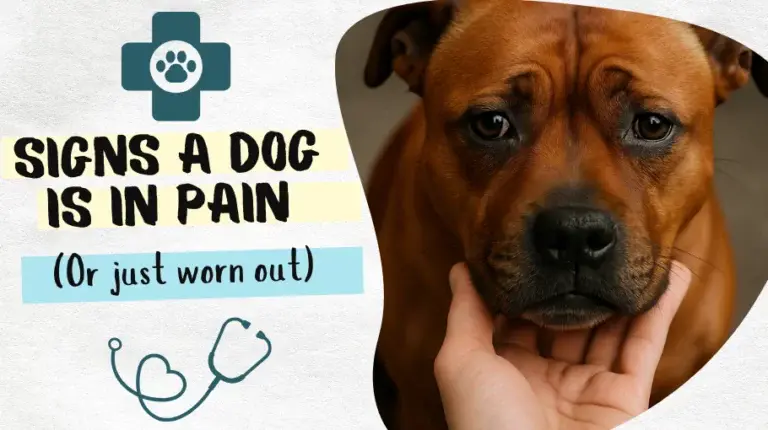9 Dog Grooming Benefits For A Healthier, Happier Short-Haired Dog

Shorthaired dogs often get a reputation for being “low maintenance,” but the dog grooming benefits they enjoy — like better hygiene, healthier skin, and stronger bonds — apply just as much to them as to longhaired breeds.
Brushing, nail trims, and quick check-ins on their skin and ears can make a huge difference in the way they feel, act, and even smell. Even short coats can hide dirt, loose hair, and small health problems, so sticking to a regular grooming routine can prevent a lot of headaches (and some hefty surprise vet bills) later on.
If you’ve got a shorthaired dog at home, you might notice fur on your furniture, that classic “doggy smell” after playtime, or itchy patches after a romp outside. Regular brushing is one of the simplest benefits of brushing a dog — it keeps your pup looking and feeling their best while giving you a chance to check for health issues early. Along the way, it also squeezes in bonding time and training, which can be a game changer for busy or anxious dogs.
Here’s a closer look at nine dog grooming benefits that make life better for shorthaired pups — and their humans.
1. Better Hygiene and Odour Control: A Key Dog Grooming Benefit
Short hair still collects dirt, pollen, and natural skin oils, especially after outdoor play or lounging in the garden. Regular brushing lifts away loose fur, dirt, and anything your dog picked up rolling around the grass. This simple step also cuts down on that “dog smell” that shows up when natural oils and grime build up on the skin and coat.
No matter how sleek their fur looks, shorthaired dogs like labs, beagles, boxers, and Staffies, can get pretty musky without a good brush now and then. I’ve found that even a quick weekly grooming session makes a noticeable difference in how clean and fresh my dogs smell indoors. Plus, your hands and your furniture don’t pick up as much residue from petting.
Another lesser-known perk: keeping up with brushing can also reduce allergens for humans, especially if anyone at home struggles with sneezing or allergies around pets. Removing loose fur and dirt keeps the air and surfaces in your home a little cleaner, providing a more comfortable space for everyone.
2. Spot Parasites and Small Wounds Early During Grooming
Brushing is a quick way to check for any “hitchhikers” like fleas or ticks. Fleas can burrow deep, and ticks especially love tricky spots like armpits, groin, or behind the ears, even on short coats. You can’t prevent ticks on dogs, but you can get them off sooner with regular checks.
Grooming also gives you a chance to notice scabs, scratches, and sore spots your dog might’ve picked up from roughhousing or exploring tall grass.
By checking your dog over before a parasite problem explodes, you skip a lot of drama (and expensive treatments). Spotting tiny wounds early means you can clean them out, apply some ointment, or grab a vet appointment before things get infected.
This proactive approach can also help you see changes in your pet’s health over time, encouraging quicker conversations with your vet and possibly preventing issues from spreading to other pets in the home.
3. Catch Skin Problems Early for Better Dog Health
Short hair makes it easier to spot skin problems, but only if you look closely now and then. Consistent grooming lets you notice flaky skin, rashes, red patches, or even weird lumps and bumps that might go overlooked. Unusual dandruff, “hot spots” from licking, bald spots, or any change in skin texture jumps out more when you take a few minutes to feel your dog’s fur and look at their skin.
This early lookout can be really helpful for flagging allergies, infections, or even more serious issues before they get worse. Sharing any changes you find with your vet helps you both make better choices for your dog’s care plan.
Sometimes dogs develop seasonal allergies or even reactions to household products, so regular grooming helps you track down causes by noticing patterns—like if certain rashes pop up after walks in fresh-cut grass or after using a new shampoo.
4. Keep Eyes and Ears Healthy With Regular Grooming Sessions
Face time during grooming means your dog’s eyes and ears are right in front of you, making it super easy to check for problems like redness, discharge, or debris. Any goop, constant head-shaking, or foul odour coming from their ears signals something might be up. Cleaning around their eyes and ears gently with a soft cloth or dog wipe helps keep these sensitive areas in good shape and catch issues before they turn into vet emergencies.
Catching gunk early keeps ear infections, eye irritations, and other problems from ruining your dog’s comfort, not to mention saving you from last-minute vet visits that can throw off your whole week.
5. Dog Nail Checks That Prevent Pain, Posture Issues, and Injury
You might notice that tap-tap sound when your dog trots across a hard floor, usually a sign their nails are getting a bit on the long side. Neglected nails don’t just look scruffy; they mess with your dog’s comfort, change how they walk, and mess with their joints. Curvy nails can break, snag, or even curve back toward the paw pad, causing pain and infection.
Keeping nails trimmed regularly helps your pup move naturally and prevents soreness. Even a basic check and occasional trim will keep their paws in good working order, which is especially important for active or older dogs.
Sensitive paws can also signal other health issues. If your dog flinches when you touch their paws, it may mean more is going on under the surface, so these regular checks are also a great way to catch any odd behaviours or injuries that might need a closer look.
6. Manage Year-Round Shedding With the Right Brush
Shorthaired dogs might not leave tumbleweeds of fur like some longhaired breeds, but they definitely shed plenty. The loose, pointy hairs from breeds like pugs, boxers and Staffies get everywhere, including your clothes and car seats – even if they’re not on them. Brushing every few days can help trap the dead hair before it sprinkles around your home, cutting way down on sweeping and lint rolling.
I’ve found a simple rubber curry brush or grooming glove works way better than your typical slicker brush for these coats. Despite the shortness of hair, it’s not finishing they need. If you’re yet to find grooming your dog to be therepeutic, check out our guide to the Best Dog Grooming Brushes for Short-Hair Breeds – some aren’t even pricey.
The best part is that your dog’s skin gets a mini massage, too, which can help blood flow and keep new hair growing strong.
During seasonal changes when dogs shed even more, increasing your brushing routine just a bit can really make a difference. Less hair in the air means you spend less time cleaning up and more time enjoying your dog’s company.
7. Prevent Painful Matting in Short-Haired Breeds
It’s easy to assume matting is only a problem for fluffy breeds, but I’ve seen plenty of odd tangles and matting in my thick-coated short-haired Staffy, and in really odd spots, like the back of his neck where he can’t be licking – his brother’s the culprit. Under the legs, behind the ears, or around the tail base are classic areas where hair twists up if it’s ignored for too long. Even sweat and dirt can “glue” short hairs together, making uncomfortable matting that pulls on the skin.
Quick combthroughs in these problem zones save your dog from unnecessary pain, especially after swimming or rainy walks. It also means you don’t have to pull or shave out tough knots later on.
8. Boost Natural Shine and Coat Health Without Expensive Products
Brushing isn’t just about hair control. Spreading your dog’s natural oils is the real prize. Those skin oils keep coats glossy, repel dirt, and help prevent itchiness. I always notice that my dog’s fur feels softer and looks shinier after a good brushing session.
Of course, diet still matters. While brushing can’t fix nutrition issues, it does help distribute the healthy stuff naturally. Pair it with good food, and your dog’s coat pretty much glows.
9. Strengthen Your Bond and Reinforce Training Commands Through Grooming
Grooming isn’t only about staying clean. It’s also an opportunity for your dog to learn patience, trust, and calm behavior around touch. I’ve seen firsthand with my anxious pup slowly relax during brushing sessions once he learned it isn’t scary.
By mixing in some of what I refer to as 11 Of The Most Essential Commands To Teach Your Dog (particularly sit, stay, paw) while you’re grooming your dog, you reinforce good habits and build a positive, trusting relationship. This extra attention makes grooming something your dog looks forward to, or at least tolerates with less fuss.
Being able to handle your dog’s paws, ears, and mouth during routine grooming can make trips to the vet or dog park less stressful for everyone involved. It also helps prepare your dog for any situation where calm cooperation is needed.
Healthier Dogs and Happier Owners are the Real Benefits of DIY Dog Grooming
Grooming a shorthaired dog might not look like a big job, but it comes with some clear benefits for you and your furry friend. From freshening up doggy odour to catching hidden health issues early, each step adds up to a happier, healthier pet. Plus, the time you spend together makes daily life smoother and keeps them feeling loved and looked after.
Grabbing a brush once or at most, a couple of times each week makes a noticeable difference before you know it. Your dog will honestly thank you in playful tail wags and warm snuggles. Regular grooming is a simple routine that pays off with a cleaner home, a healthier pet, and a stronger bond—a win for everyone!
It doesn’t take much time, nor do quality tools have a high price tag. Some of the Best Dog Grooming Brushes (or even just Grooming Mitts) cost less than the price of a takeaway for one.
Perhaps the largest win of the many DIY dog grooming benefits is the quality and intimate bonding time with your pet. With just a few minutes each week, you’re setting your pup up for a happier, healthier, and more eye-catching life!







Regular grooming has made a huge difference for my little beagle, both in appearance and overall health. When I first got the rubber brush (curry brush I think it’s called), I never imagined how much loose fur and dirt could build up even on a coat that looks “low-maintenance.” Over time, consistent brushing not only reduced shedding but also improved his skin condition and made his coat noticeably shinier. What surprised me was that he’s taken a shine to it so it’s made brushing something we both look forward to rather than a chore.
That’s great, Slavisa. And yeah, the rubber brushes (if it’s got the flexi spiky bits on them) is the curry brush. They sure do get some amount of hair off, and give them a cracking sheen that lasts for a while. Better than any doggy shampoo.
This post does a wonderful job highlighting how even short-haired dogs benefit enormously from regular grooming! I particularly appreciated how you emphasize that grooming isn’t just about appearance—it supports hygiene, helps spot skin or ear issues early, and enhances that special bonding time between pet and owner.
I can relate personally—my two Shih Tzus have longer coats and stay groomed, though we keep their hair more on the natural side rather than getting it trimmed short. I’m curious: since long coats bring their own challenges—like managing mats or ensuring the coat stays healthy—do you think the grooming benefits you mention (like early detection of issues or reducing odors) apply even more strongly to long-haired breeds? Are there extra grooming priorities you’d highlight for dogs like mine?
Thanks, Leahrae! A friend of mine has a Shih Tzu, and I’ll walk him sometimes—but I avoid tall grass since ticks are a pain to spot in that long coat. Shih Tzus have long hair and are double-coated, so they don’t shed much anyway and do a decent job of staying clean on their own. But regular brushing is key—not just for getting dirt off, but for coat health and shine. Plus, it’ll help catch any sneaky hitchhikers. As for “extra grooming priorities”… for Shih Tzus, I’d say hair clipping—particularly around the eyes. So yeah, there are definitely benefits that go well beyond just appearance!